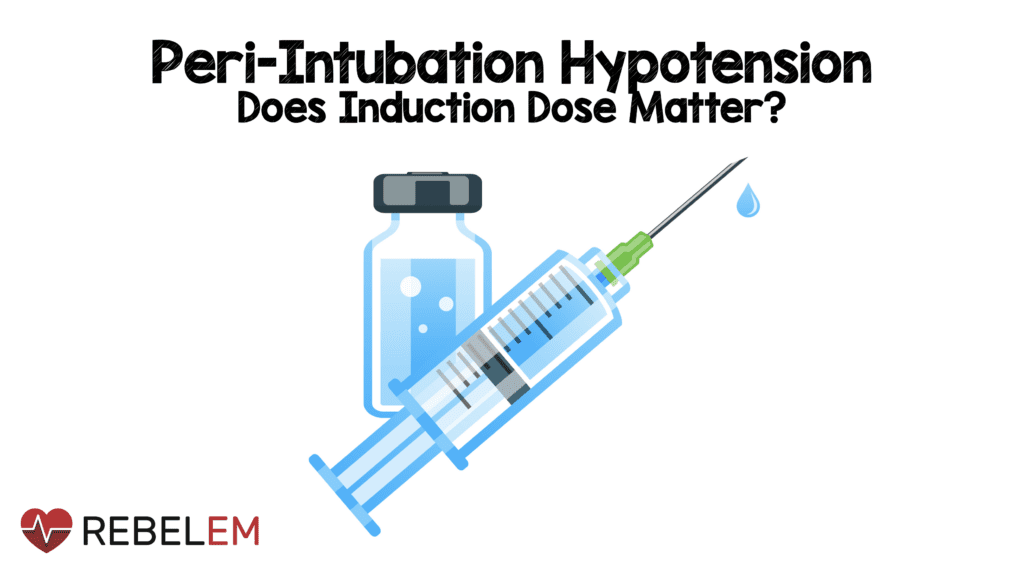
 Background: Rapid Sequence Intubation (RSI) is a procedure fraught with potential complications including hypotension which, in turn, can result in cardiovascular collapse. While there are numerous potential causes of hypotension peri-RSI, induction medications represent an important, modifiable variable. Over the last decade, airway experts have advocated for reduced induction agent dosing to lessen the risk of hypotension particularly in at risk patients. This approach has been shown to benefit patients when agents like propofol and midazolam are used. (Russotto 2022, Choi 2004). However, there is scant evidence on the more common induction agents ketamine and etomidate.
Background: Rapid Sequence Intubation (RSI) is a procedure fraught with potential complications including hypotension which, in turn, can result in cardiovascular collapse. While there are numerous potential causes of hypotension peri-RSI, induction medications represent an important, modifiable variable. Over the last decade, airway experts have advocated for reduced induction agent dosing to lessen the risk of hypotension particularly in at risk patients. This approach has been shown to benefit patients when agents like propofol and midazolam are used. (Russotto 2022, Choi 2004). However, there is scant evidence on the more common induction agents ketamine and etomidate.
Paper: Driver BE et al. Sedative Dose for Rapid Sequence Intubation and Postintubation Hypotension: Is There an Association? Ann Emerg Med 2023. PMID: 37389494
Clinical Question: Is the dose of etomidate or ketamine associated with postintubation hypotension?
Population: Patients > 14 years of age who underwent RSI with either etomidate or ketamine from the National Emergency Airway Registry (NEAR).
Outcomes:
- Primary: Postintubation hypotension (SBP < 100 mm Hg) 15 minutes post-intubation.
- Secondary: Postintubation hypotension treated with IV fluids or vasoactive agents.
Independent variable studied: Etomidate and ketamine drug dose. Standard dosing is etomidate 0.3 mg/kg and ketamine 1.5 mg/kg.
Design: Secondary analysis of data from a prospective registry.
Exclusion: Intubation primarily performed with topical anesthesia, patients with missing data for the primary outcome, patient weight, etomidate/ketamine dose or preintubation hemodynamic status.
Results:
|
Etomidate |
Ketamine |
|
|
Patients Included |
12,175 |
1,849 |
|
Median Drug Dose |
0.28 mg/kg |
1.33 mg/kg |
|
Hypotension Prior to RSI |
14.1% |
33.0% |
Multivariable model analysis for association with postintubation hypotension
- Etomidate: aOR 0.95 (95% CI 0.90 – 1.01)
- Ketamine: aOR 0.97 (95% CI 0.81-1.17)
- Bottom Line Findings: Neither etomidate or ketamine dose significantly associated with post-intubation hypotension (primary outcome) or hypotension requiring fluids (secondary outcome)
Strengths:
- Asks a clinically important question with limited available data.
- Large database to extract patients from for analysis.
- Broad inclusion criteria.
Limitations:
- Observational study with no randomization.
- Unclear why patients were selected for ketamine or etomidate as the induction agent.
- Unclear why specific dosing was selected and unclear if reduced dose selected specifically in those at risk for post-intubation hypotension or not.
- No availability of details on treatment outside of induction agent.
Discussion:
- Mechanistically, we should not expect dosing of ketamine or etomidate to effect hemodynamics.
- Prior studies show reduced dosing of propofol, midazolam and barbiturates decreases their effect on hemodynamics. These agents have intrinsic hemodynamic effects.
- Etomidate and ketamine do not have intrinsic, drug-specific effects on blood pressure.
- Thus, changing dose should not effect hemodynamics.
- There are many reasons for post-intubation hypotension including inadequate/incomplete resuscitation and ongoing hemorrhage.
- Induction medication choice and dosing represents one potential issue.
- Without randomization and details about interventions, resuscitation and medications administered, cannot draw additional conclusions.
- Hemodynamic optimization should be the pre-intubation priority in order to avoid post-intubation hypotension.
- IV fluids where appropriate
- Push dose pressers
- Vasopressor drips
- The flip side of reducing sedative dose could be an untoward consequence of awareness with paralysis (ED-AWARENESS STUDY)
Author Conclusion: “In this large registry of patients intubated after receiving either etomidate or ketamine, we observed no association between the weight-based sedative dose and postintubation hypotension.”
Clinical Take Home Point:This data does not show association between induction dose of ketamine or etomidate and post-intubation hypotension. However, the available evidence does not allow conclusions to be drawn due to it’s limitations. Based on the pharmacology of these drugs and the available evidence, we should not rely on reduced dose to mitigate the hemodynamic effects of intubation and should focus our efforts on pre-intubation hemodynamic optimization.
References:
- Russotto V, Tassistro E, Myatra SN, et al. Peri-intubation cardiovascular collapse in patients who are critically ill: insights from the INTUBE study. Am J Respir Crit Care Med. 2022;206:449-458. PMID: 35536310
- Choi YF, Wong TW, Lau CC. Midazolam is more likely to cause hypotension than etomidate in emergency department rapid sequence intubation. Emerg Med J. 2004;21:700-702. PMID: 1726487
Post Peer Reviewed By: Salim R. Rezaie MD (Twitter: @srrezaie)
The post Peri-Intubation Hypotension – Dose Induction Dose Matter? appeared first on REBEL EM - Emergency Medicine Blog.
